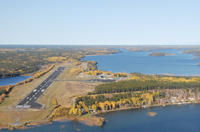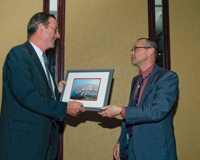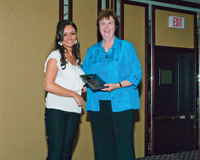
Features
Operations
A Century of Achievement
Aviation associations play an important role in Canadian aviation, none more so than the Manitoba Aviation Council (MAC).
July 14, 2010 By Roger Beebe
Aviation associations play an important role in Canadian aviation, none more so than the Manitoba Aviation Council (MAC). Promoting, facilitating and protecting the development of all facets of aviation within the province of Manitoba, the MAC’s mission is carried out through involvement in training, affiliations with other aviation groups, and staying current with regulatory changes and arising issues. The council represents some 250 entities and individuals, with a salaried staff and many volunteer members carrying out its work.
 |
|
| Manitoba Aviation Council plays a vital role in keeping Manitoba’s entire aviation sector up to date on current activities. PHOTO: BILL JACKSON
|
The aviation and aerospace industry is a large economic generator in Manitoba, and much of the industry has reacted well to the recession. The need for air transport in Manitoba ensures a lot of activity in transporting goods and people to remote communities, especially when it comes to medical aid. For towns with no summer road access, aviation is a time-effective way to provide medical care and evacuation, but it requires modern and robust navigation and airport facilities. This is an area of great interest to MAC. MAC also plays a vital role in keeping Manitoba’s entire aviation sector up to date on current activities, including liaising with the aerospace industry, airports, local governments and military units based in Manitoba.
Manitoba’s geographic location is often referred to as “in the middle.” Additionally, the term is indicative of how provincial aviation associations are in between the federal and provincial government’s jurisdictions. The federal government regulates civil aviation, with the provinces controlling most infrastructure and business opportunities. In Manitoba, there are 22 provincially owned and operated airports. The lone federally owned airport is located in Churchill. MAC often has to navigate between the different governments, as well as municipalities and First Nations jurisdictions, which makes for a challenging and interesting environment for MAC board members and the general membership.
 |
|
| The aviation and aerospace industry is a major economic generator in Manitoba. photo: BILL JACKSON |
At one time, aviation councils existed in all western provinces, but today, Saskatchewan, British Columbia and Manitoba keep the original titles. Aviation Alberta has replaced the previous council with much the same mandate. Northern Canada is represented by the Northern Air Transport Association. There is some overlap among membership, making for healthy interchange of options and knowledge.
On Dec. 31, 2009, Judy Saxby, an experience air carrier executive, resigned from the position of president. Craig Skonberg took over the role until May 19, when Dennis Lyons was elected president.
Lyons is the person responsible for maintenance for Fast Air Ltd., providing executive aviation services from its base in Winnipeg. He is a member of the CAMC Board of Directors. Locally, Lyons is the Chair of the Advisory Council for Red River College’s Aircraft Maintenance Engineer programs and a member of the Board of the Central Aircraft Maintenance Engineers Association. Lyons has been in the aviation industry since 1979, serving first with the Canadian Armed Forces and then running his own company for 10 years providing aircraft maintenance and consulting services. Prior to accepting this position, Lyons was MAC’s coordinator for SMS information meetings between operators and Transport Canada.
Saxby, the former VP of Keewatin Air, led MAC before stepping down in 2003. She served as president a second time to help rebuild the organization after retiring from Keewatin Air. Saxby contributed a wealth of experience and energy to the job. She encouraged council growth to represent all of Manitoba’s very important air operator companies.
Bill Zuk, MAC’s Executive Officer, manages the office and the daily work of the council with help from the office manager, Linda Sevick, who focuses on training initiatives. Zuk manages an active training system, which provides much needed training to Manitoba’s aviation industry. Up to 1,000 students now annually attend courses set up by MAC training. Several training programs are scheduled yearly, dealing with topics from SMS implementation to first aid training.
One of the important aspects of MAC’s work in the industry is hosting an annual general meeting, conference and trade show.
14th AGM a Success
This year, the MAC commemorated a century of the province’s aviation achievements at its AGM and trade show, appropriately themed Celebrate 100 Years. Some 150 aviation leaders and practitioners gathered in Winnipeg on April 21 and 22 to participate in presentations, attend a gala dinner and peruse booths and displays from 15 local and national organizations.
 |
|
| Manitoba Aviation Council 2010 Pioneer of Flight award winner Bill Jackson, left, of Jackson Air, receives a commemorative painting from Craig Skonberg, MAC then-president. PHOTO: Robert Dearden |
At the general meeting, four new directors were added to the board: Roger Beebe, John Fondse, Cindy Westphal and Dennis Lyons, who was elected MAC’s new president in May.
The council, first formed in the 1960s, has come a long way in a short time. This was the 14th annual general meeting featuring a conference, and the sixth to incorporate an industry trade show. Attendees also had the opportunity to attend the Canadian Aviation Maintenance Council (CAMC) members “fact finding” meeting and a Canadian Owners and Pilots Association (COPA) meeting, both held on April 20 in conjunction with the MAC conference.
Over the two-day event, many of the who’s who in aviation associations entertained and informed attendees. Among the presenters were John McKenna, president and CEO of ATAC; Robert Donald, executive director of CAMC; Sam Barone, president and CEO of CBAA; Kevin Psutka, president and CEO of COPA, and Curtis Ross, chair of the Regional Community Airports Coalition of Canada (RCACC).
The informative presentations and seminars covered a variety of topics, including business and legal issues, workplace dynamics, the current economic situation, history, education, liability issues, new technology, risk management tactics and safety management systems (SMS). The Hon. Steve Ashton, Manitoba’s Minister of Infrastructure and Transportation, presented the annual Manitoba Aviation Week proclamation recognizing the contributions of the industry to the province’s economic well-being.
Pioneer of Flight award
One of the highlights of the MAC conference is the Pioneer of Flight award dinner. MAC established the award in 2006 to recognize achievements that have led to aviation development in Manitoba. This year’s award honoured Bill Jackson of Jackson Air. Jackson has been in business for 30 years, starting in Saskatchewan before moving to Flin Flon. His company, Jackson Air Services, operates a charter service specializing in aerial survey and photography. In the spring of 2007, Jackson Air sold the floatplane base to Wings over Kississing. It operates a complete line of float aircraft out of the Channing Base. In December 2007, Missinippi Airways bought the hangar at the Flin Flon Airport as well as two aircraft. They now operate from the Flin Flon base, using King Air and Piper Chieftain aircraft. Jackson has been very active in the repair, overhaul and rebuilding of aircraft, and currently operates the unique Partenavia P68-Observer for fire patrol contract and mapping/surveying work. He also actively serves the mining, tourism and health industries in Manitoba, and is highly involved in the community of Flin Flon. Jackson has left his mark as a member of many aviation organizations including MAC, the Air Transport Association of Canada (ATAC), and the Saskatchewan Aviation Council.
The previous winners of the MAC Pioneer of Flight are:
- 2006: Arnold Morberg and family (Calm Air International)
- 2007: James A. Richardson and family (Western Canadian Airways, Canadian Airways)
- 2008: Tom Lamb and family (Lambair)
- 2009: Bill Wehrle and family (Peri-meter Aviation)
99s Rosella Bjornson Scholarship
At the MAC’s AGM gala evening dinner, Captain Rosella Bjornson presented the 99s Rosella Bjornson Scholarship to student pilot Adelinde (Addy) Grobler. The scholarship is named after Rosella, who was a trailblazer for women in commercial jet service in North America.
Grobler has a private licence and intends to use the $2,000 scholarship towards her night rating at Winnipeg Aviation at the St. Andrews Airport. She is also currently a full-time student at the University of Winnipeg.
Bjornson, a member of the Canadian Aviation Hall of Fame, began her flying career at the Winnipeg Flying Club and in 1973 joined Transair, becoming the first female pilot in Canada to be hired by an airline. In 1990, she became the first female captain with Canadian Airlines. After taking a mandatory, unpaid leave of absence during her first pregnancy in 1979, Bjornson was instrumental in changing those regulations to allow a pregnant pilot to fly.
 |
|
| Student Adelinde Grobler, left, received the 99s Rosella Bjornson Scholarship from Rosella Bjornson at the MAC 2010 Conference. PHOTO: Robert Dearden |
When it comes to people joining together in support of an industry, associations such as MAC are necessary to work effectively with all parties involved. Many regulatory bodies affect aviation. Vigilance is key, as issues seem to arise from nowhere. MAC is frequently dealing with airport issues such as access, equipment and operations, a recent issue being the Airline Passenger’s Bill of Rights. It can be overwhelming trying to keep up with changes and regulatory initiatives. If you’re in the aviation business in Manitoba, consider joining MAC and to help promote the industry.